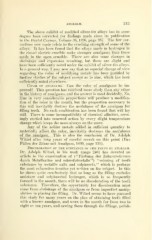Page 643 - My FlipBook
P. 643
AMALGAM, 313
The above exhibit of modified silver-tin alloys has in some
degree been corrected for findings made since its publication
in the Dental Cosmos, Volume 38, 1896, page 987. The few cor-
rections now made relate to the crushing strength of some of the
alloys. It has been found that the alloys made in hydrogen in
the closed electric crucible make stronger amalgams than those
made in the open crucible. There are also some changes in
shrinkage and expansion resulting, but these are slight and
have been sufficiently noted under the exhibit of silver-tin alloys.
In a general way, I may now say that no especial change of view
regarding the value of modifying metals has been justified by
further studies of the subject except as to zinc, which has been
sufficiently noted elsewhere.
Color of amalgams. Can the color of amalgams be im-
proved? This question has received more study than any other
in the history of amalgams, and the answer is most decidedly. No.
Zinc in very considerable jiroportions will produce a modifica-
tion of the color in the mouth, but the proportion necessary to
this will inevitably destroy the usefulness of the amalgam for
filling teeth. No such combination has been found that will lay
still. There is some incompatibility of chemical affinities, seem-
ingly excited into renewed action by every slight temperature
change which keeps the mass always on the move.
Any of tbe nobler metals added in sufficient quantity to
materially affect the color, inevitably destroys the usefulness
of the amalgam. This is also the conclusion of Dr. Adolph
Witzel after long years of careful search on this point (Das
Fiillen der Zahne mit Amalgam, 1899, page 131).
Discoloration of the substance of the teeth by amalgam.
Dr. Adolph Witzel, in his work (page 240) has devoted an
article to the examination of ("Farbung der Zahnsubstanzen
durch Metallsaltze und schwefelmetalle") "coloring of tooth
substance by metallic salts and sulphurets," which is perhaps
the most exhaustive treatise yet written on the subject. In this
he shows quite conclusively that so long as the filling excludes
moisture and sulphureted hydrogen, which is so frequently
formed in the mouth, there will be no discoloration of the tooth
substance. Therefore, the opportunity for discoloration must
come from shrinkage of the amalgam or from imperfect manip-
ulation in placing the filling. Dr. Witzel seems to have pursued
this study for many years on the plan of obtaining teeth filled
with a known amalgam, and worn in the mouth for from two to
eight or ten years, and sawing these through the fillings, polish-


